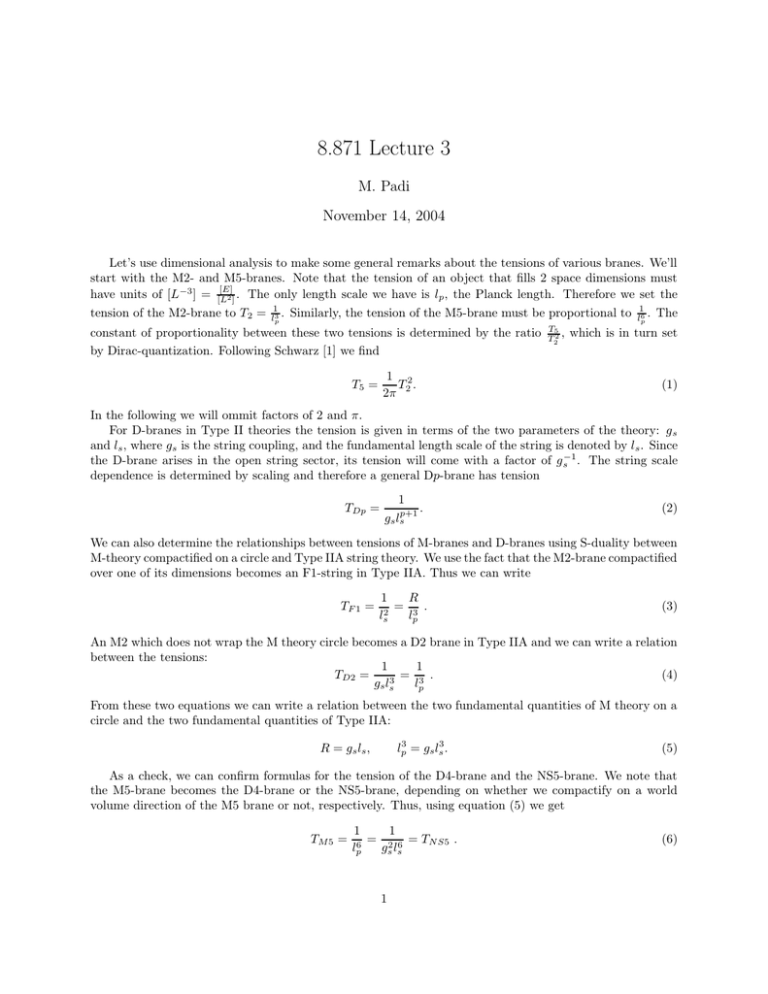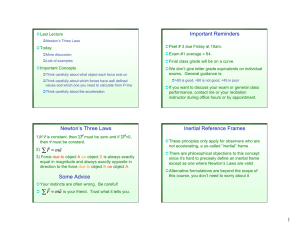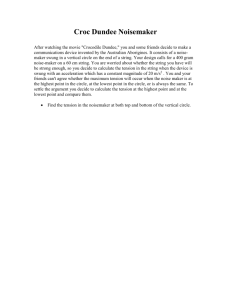8.871 Lecture 3 M. Padi November 14, 2004
advertisement

8.871 Lecture 3 M. Padi November 14, 2004 Let’s use dimensional analysis to make some general remarks about the tensions of various branes. We’ll start with the M2- and M5-branes. Note that the tension of an object that fills 2 space dimensions must [E] have units of [L−3 ] = [L 2 ] . The only length scale we have is lp , the Planck length. Therefore we set the tension of the M2-brane to T2 = l13 . Similarly, the tension of the M5-brane must be proportional to l16 . The p p constant of proportionality between these two tensions is determined by the ratio by Dirac-quantization. Following Schwarz [1] we find 1 2 T . 2� 2 T5 = T5 , T22 which is in turn set (1) In the following we will ommit factors of 2 and �. For D-branes in Type II theories the tension is given in terms of the two parameters of the theory: g s and ls , where gs is the string coupling, and the fundamental length scale of the string is denoted by ls . Since the D-brane arises in the open string sector, its tension will come with a factor of g s−1 . The string scale dependence is determined by scaling and therefore a general Dp-brane has tension TDp = 1 . gs lsp+1 (2) We can also determine the relationships between tensions of M-branes and D-branes using S-duality between M-theory compactified on a circle and Type IIA string theory. We use the fact that the M2-brane compactified over one of its dimensions becomes an F1-string in Type IIA. Thus we can write TF 1 = 1 R = 3 . 2 ls lp (3) An M2 which does not wrap the M theory circle becomes a D2 brane in Type IIA and we can write a relation between the tensions: 1 1 TD2 = = 3 . (4) 3 g s ls lp From these two equations we can write a relation between the two fundamental quantities of M theory on a circle and the two fundamental quantities of Type IIA: lp3 = gs ls3 . R = g s ls , (5) As a check, we can confirm formulas for the tension of the D4-brane and the NS5-brane. We note that the M5-brane becomes the D4-brane or the NS5-brane, depending on whether we compactify on a world volume direction of the M5 brane or not, respectively. Thus, using equation (5) we get TM 5 = 1 1 = 2 6 = TN S5 . lp6 gs ls 1 (6) Indeed the NS5-brane is a solitonic object and should have a tension which is proportional to the inverse square of the string coupling. Furthermore, TD4 = RTM 5 = R 1 , = lp6 gs ls5 (7) in agreement with equation (2). We also know that the Type IIB theory at coupling gs is S-dual to itself at coupling gs� = 1/gs . Under this duality, the D1-brane becomes the F1-string, the D3-brane is self-dual and the D5-brane becomes the NS5-brane. So now we have the following equalities: TD1 = TF 1 1 gs ls2 1 = 2 ls 1 ls�2 1 = � �2 gs ls = TF� 1 = = � TD1 (8) (9) From these equations we can derive the following relation between ls and ls� : ls�2 = gs ls2 . (10) References [1] J. H. Schwarz, “Lectures on superstring and M theory dualities,” Nucl. Phys. Proc. Suppl. 55B, 1 (1997) [arXiv:hep-th/9607201]. 2


